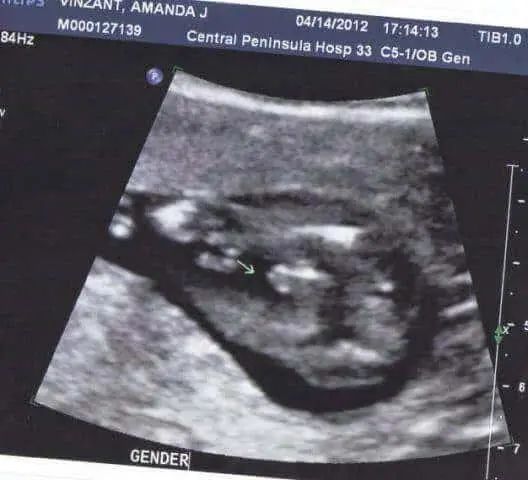Already being the mom of two little boys, I was admittedly a bit disappointed at my 16-week ultrasound with my third child when the tech said she thought the baby was a boy. I was thrilled, of course, he was healthy, but still, deep down, I was hoping for a girl.
Looking at my ultrasound photo, which you can see below. I would agree. My baby looked like a boy, but I did note the ultrasound photos looked different from images of my other two sons at about the same gestational age. I started doubting gender scan accuracy and wondering if ultrasounds can be wrong. After looking to the internet for answers, it turns out that early ultrasound photos are often mistaken. Even though, in the end, my baby was actually a boy, here’s hope for all those who are hoping for a verdict of “ultrasound wrong.”

Boy Ultrasound Wrong: How in the heck could a girl look like a boy?
There are two ways a girl can be mistaken for a boy in early ultrasound photos. The first is simple. The ultrasound tech or doctor sees an umbilical cord between the legs and mistakes it for male genitalia. This can actually happen at any gestational age, making a clear image pretty important if you plan to buy non-neutral gender baby goods.
Second, many parents are aware that all babies start off appearing as the same sex. The misconception is that all babies begin with genitals that resemble female anatomy, and if there is a dangly thing between the legs, you have a boy. That isn’t the case. During the early weeks of external gender development, both male and female babies have a dangly part down there as well as a bulbous area. You can see a clear visual aid and explanation here.
Somewhere between 9 and 12 weeks, the “dangly” part in the center forms the clitoris of a girl or the penis of a boy. The bulbous area becomes either a scrotum or labia. This means a, say, 11-week shot with a clear sack-like shape and tiny dot in the middle that looks a little like the “turtle head” image said to indicate a boy could be a girl still in development. It’s because of this that gender scan accuracy is greater after the 20th week when, in the majority of babies that have been accurately aged, external-sex organ development is complete, and the baby is larger.
Girl Ultrasound Wrong: Can a girl turn out to be a boy then?
It’s less common to be told your baby is a girl based on a gender scan and actually end up with a boy, but it does happen. For example, if the image isn’t very clear or from a bad angle, there may not appear to be male genitalia even if there is. Inexperienced techs often assume no penis means a girl. For a confirmed girl ultrasound, typically, you want to see three lines indicating the shape of a vagina. Again, this is why 3D ultrasound is generally more accurate in predicting gender.

Can you tell if a baby is a girl or boy by ultrasound before the 20-week mark?
You can’t get much more than a guess, a solid guess if you are approaching 20 weeks. In all four of my pregnancies, gender was very clear by 16-17 weeks. There is also the angle of the dangle theory.
It suggests between 12 and 15 weeks, when looking at a side view, if the dangly middle part is at a 30-degree angle or greater with the spine, your baby is likely a boy. If it’s 30 degrees or under, then you likely have a girl. The 30 degree on the dot mark leaves you still without hints. Basically, is the dangle pointing more up towards your baby’s head (boy) or down at the toes (girl)? Either way, this guess is still only about 50% accurate. With these early scans, normal Doppler ultrasounds are recommended. After the 20th week, 3D ultrasounds are generally more accurate.
If you are experiencing a bit of gender disappointment, have faith, my fourth child was a girl!
If you enjoyed, “Boy or Girl Ultrasound Wrong? Gender Scan Accuracy,” you might also like:
Baby Gender Prediction Quiz based on the science of gender swaying
